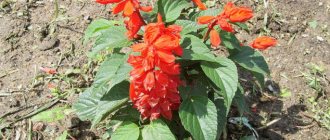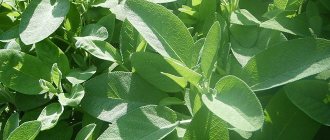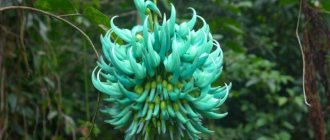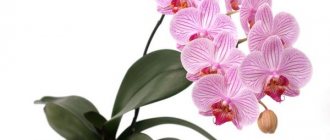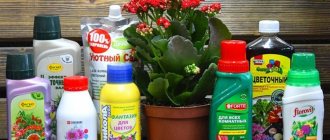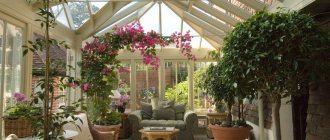From Latin, Sálvia Divinórum is translated as “sage of fortunetellers,” in other words, narcotic sage. The leaves of this plant contain a psychoactive hallucinogen called salvinorin A, which has dissociative properties. As a cultivated plant it bears its Latin name - Salvia Divinorum. This type of sage does not differ in structure from other representatives of the sage genus: a perennial, from the rhizome, first an herbaceous plant, then a subshrub. It grows mainly in the subtropics, but if protected from frost, Salvia Divinorum will survive in colder climates. The ban on growing this plant is due to its properties, which we will discuss later.
Botany
Salvia Divinorum has a densely branched woody root. The stem is simple, ascending, sometimes branched, and has a square cross-section. If it grows in natural conditions, then the bush is quite tall - up to two meters. Again, it propagates vegetatively in natural conditions - by cuttings; any fragments of the stem take root well upon contact with moist soil and give birth to new plants.
The leaves of Salvia Divinorum are large, they reach twenty centimeters, simple, oval, whole, beautiful emerald color, with fine hairs. The edge of the leaf is round-toothed, the leaves are arranged oppositely. The flowers are complex, whorled, typical in shape for all Lamiaceae, the petals are white, the stamens are purple, collected at the end of the stem in spike-shaped inflorescences. The fruit is an ordinary achene.
More about the plant
The habitat of Salvia Divinorum is not very large in the wild - its homeland is Central America, most of all in Mexico (Oaxaca). This is a fairly water-loving plant that grows well in the shade on regularly moistened and drained soil. It was discovered for the first time in the Sierra Madre region, where it is still used by the Mazatec Indians in shamanic rituals.
In small dosages, the leaves of this plant are used to treat anemia, diarrhea, rheumatism and bloating, and are also taken as a diuretic. That is, Salvia Divinorum is not only a beautiful, but also a useful plant, but the harm from it is much greater, since addiction occurs, and an overdose can result in death.
Planting salvia in open ground
When is planting in open ground carried out?
For such a plant, sandy, light soil is suitable, which should drain water well and be enriched with humus and lime. Choose a well-lit place, as this is a light-loving plant. However, salvia adhesive is suitable for growing in a shaded area. Planting in open soil can be done after there are no frosts at night. This time most often falls on the first days of June.
Danger
Even the leaves of ordinary salvia can cause very negative effects when taken in large quantities (usually through smoking): this is not only a bad experience, but also a threat to lung health. Some fans of traveling to other realities do not consider a plant called Salvia Divinorum to be a drug; a ban on its cultivation is considered an inadequate measure.
However, even they admit that traveling to other realities with the help of the sage of fortune tellers can end very badly - a person loses control over himself, can injure himself, fall, or get injured of any severity. Usually, the drug addict gets the main thrill from the end of the action of the Salvia Divinorum extract, since during the action his behavior shows the highest degree of discomfort.
When and how does it bloom
Flowering time and its duration depend not only on the variety, but also on the growing conditions.
Types of flowers
Tubular pyramidal flowers are collected in inflorescences. Depending on the variety, their number can reach up to 100 pieces. The length of each is at least 20 cm.
Inflorescences-spikelets
Flower shapes
Regardless of the variety, all inflorescences are spike-shaped. The stem is literally completely covered with flowers.
Flowering period
Depending on the variety, the flowering period of sage varies.
Note! The first flowers appear in June, and the last ones at the very end of autumn.
Changes in care during the flowering period
During the period of active budding and flowering, it is necessary to reduce watering, but the soil should not be allowed to dry out. Fertilizing with mineral fertilizers is another factor that promotes abundant and long-lasting flowering. If this procedure is not carried out on time, the inflorescences will begin to turn yellow and look old.
Story
For the first time, Salvia Divinorum, the cultivation of which had not yet spread throughout the world, was discovered and described in 1939. And this was done by the scientist Jean Bassett Johnson, who studied Indian shamanism. The scientific discovery occurred even later - in 1962, as a result of the expedition of chemist Albert Hofmann and ethnobiologist Gordon Watson, who went to Mexico specifically to study this plant.
The mechanism of action on the human body was not established until the end of the 90s, when a group of ethnobotanists led by Daniel Siebert began scientific experiments. How Salvia Divinorum was historically cultivated, the law prohibiting which appeared only in some countries, including the Russian Federation, is practically unknown, and it is not possible to study this subject.
Usage
Due to the small range of this particular species of sage, only one group of Indians used it, and they cannot report how domestication took place.
There is a lot of information about how the leaves of Salvia Divinorum were used by Indian shamans: they chewed them, gradually entering a trance, after which they acquired the gift of clairvoyance and predicted the future. The most experienced ones made a drink from salvia, after drinking which they could guess with 100% accuracy the events already happening and those to come, determine the cause of the illness of the people who turned to them, and even predict their fate.
Chemistry
The main psychoactive substances contained in the leaves of the plant are salvinoril A and salvinoril B. They belong to complex organic compounds of diterpenes. Salvia Divinorum also has other fractions of these compounds - C, D, E and so on - six in total, but their concentration is quite small, and the effect on the human body has been practically unstudied. Fresh leaves contain 0.022 percent salvinoril, while dry leaves contain 0.18 percent. The surprise for scientists was that the action is due to the activation of kappa opioid receptors, which is why the psychedelic effect is so great.
Salvinoril A, as it turns out, is the most powerful plant-based hallucinogen known to date. Its potency is ten times greater than psilocycin, and in terms of psychedelic activity it is close to the semi-synthetic hallucinogen known to everyone as LSD. Perhaps this information is slightly exaggerated by the advertising campaign waged by distribution agents who are doing everything to seduce the youth of our country from the path of a healthy lifestyle.
Ban
Since 2009, Salvia Divinorum has been included in List 1 of the List of Narcotic Drugs. The law of the Russian Federation classifies it as psychotropic substances and their precursors, which are subject to control, and their circulation is completely prohibited. In April 2009, by a decree of the sanitary doctor of the Russian Federation, smoking mixtures and flavors containing sage of fortune tellers were banned due to the content of toxic substances in its composition.
Also, this plant and its component salvinoril A are included in the lists of controlled substances in many other countries - Belgium, Australia, Germany, Italy, Denmark, Spain, Sweden, Finland, Japan and some US states. These states have banned both salvinoril and the plant itself, called Salvia Divinorum.
Growing
This flowering plant is almost impossible to propagate by seeds; most often the grower will face failure. But the cuttings take root perfectly. Even if a twig of five to ten centimeters, spontaneously breaking off, falls on damp and soft ground, it takes root. Under cultural conditions, cuttings are rooted either in water or in favorable substrates, for example river sand. To do this, take a small pot or even a plastic cup, fill half of it with soil, into which freshly cut Salvia Divinorum is planted two to three centimeters deep, the cuttings of which are covered with a glass container or a plastic bag.
It is better to keep the plant in the shade until it takes root, then after a couple of weeks you can begin to lightly feed it. The roots grow very quickly, occupying the entire space of the container, so it is undesirable to delay replanting. It is better to replant into a much larger container. An adult Salvia Divinorum, the seeds of which some amateur plant growers still manage to germinate, requires a very large pot, as well as regular feeding. However, it is important not to overdo it. Salvia Divinorum is very sensitive to overdose.
Salvia propagation
Perennial species of salvia are very easily propagated by semi-lignified cuttings. Moreover, it can be carried out throughout the season. To do this, we cut cuttings about 15 cm long. We root them in a container with water, slightly covering them from sunlight. The roots should appear after 14-16 days, and they can be planted literally a week after the roots appear. Salvia is also very easy to propagate by air layering: just press the branch to the ground, securing it with a metal bracket, and within a few months new roots will appear on the stem. After roots form on the branch, it can be cut off from the main bush and planted in a new place.
Salvia seedlings All salvia species reproduce well by seeds. Towards the end of October they are sown in small beds. In spring, young plants are planted in a permanent place. You can sow salvia seeds in the spring - in early March. To do this, small containers are filled with light nutritious soil (a universal soil mixture for seedlings is suitable). As soon as the seedlings acquire a couple of true leaves, they are picked (transplanted) into pots with a diameter of about 7 cm. Around mid-April, the seedlings begin to slowly harden off, for which they are taken out into a greenhouse. Strong seedlings can be planted in open ground only in early June - young sage plants are very afraid of even slight frosts.
Exclusive
The one-of-a-kind flower is grown in the country quite often, although Divinorum is almost not present; simply sage is welcomed, which also has many romantic names, for example, life-prolonging. The homeland of the common Russian dacha plant is considered to be the south of Europe, where it is also a sacred herb and has considerable medicinal properties.
Hippocrates called the healing properties of sage life-saving, and the ancient Egyptians used it to rejuvenate the body and use its effect on childbirth. When the bloody wars ended, sage was brewed in every kitchen and added to all dishes - the ability to conceive increased, the population was restored and grew. In addition, some magical properties were attributed to sage, especially in Ancient Egypt. And now both children and adults are treated with sage for any cold, cough, toothache, or inflammation of the oral mucosa.
What does salvia or sage look like?
Salvia is a flower whose description begins with the medicinal qualities of the plant. It has another more well-known name - sage. The literal translation of “salvia” is healthy. The height of the plant varies from 25 to 80 cm. Perennial salvia can even reach 1.5 m. Most often it looks like a bush or semi-bush.
Varieties of inflorescences delight the eye
Which family does it belong to?
What is salvia? This is a plant that belongs to the Lamiaceae family. Decorative, flowering perennial, which is not only medicinal, but also essential oil. It can be used as a medicinal tincture or as a seasoning.
Grows in almost all tropical regions.
On a note! The only region where salvia does not grow at all is Australia.
In its natural environment it grows in sunny places. He loves rocky areas, wastelands and extremely dry fields.
Briefly about the history of appearance
The first mention of the salvia flower can be found in the literature of the Roman Empire. It was brought to Europe much later, around the 18th century. At that time, a real boom in the development of decorative floriculture and horticulture had just begun.
Plant characteristics
Externally, the flower looks very unusual. In some countries it is called the "sacred herb". The root of the culture is powerful, lignified, and has many branches. The stems are straight, rich in leaves, woody in the lower part, softer in the upper part.
The culture exudes a strong aroma. Small flowers are collected at the end of the shoot into an inflorescence resembling a spike.
Since ancient times, salvia has been attributed medicinal qualities. There is a belief that it can prolong life. Sage tincture helps treat coughs, relieves acute toothache, and softens colds. Salvia officinalis, or sage, is the most popular spice in Britain.
Note! It can be stored for a long time even in dry form; even in this case it does not lose its medicinal qualities.
Species diversity
Salvia Divinorum is a type of sage, a perennial, in harsh climates it loses this quality and lives for two years at most, since it does not tolerate frost. As it is on the list of prohibited plants due to its strong hallucinogenic effect, it cannot be grown in the countryside, since this is prohibited by law.
Salvia sparkling (shiny) - in beauty it is absolutely not so simple, it can be compared with the inflorescences of a plant such as Salvia Divinorum, photo of flowers. Its seedlings are grown from seeds to decorate any flower bed: not very tall, up to fifty centimeters, bushes with white, pink, purple panicles. And this is not a perennial plant in our latitudes, most often it is annual, sometimes biennial.
Salvia sparkling seeds are germinated in the same way as cosmos or chamomile. The sowing is covered with glass in order to create a microclimate and keep the soil moist. It is better to water with a spray bottle so as not to accidentally wash out the seeds. After two or four weeks, shoots appear. The shoots are extremely small and delicate. Too dense shoots need to be thinned out, but carefully, preferably with tweezers, because neighboring plants are easily damaged. At first, salvia grows very, very slowly. If the sprouts become very elongated and thin, add moist soil under them, as if gently hilling them up. After the real leaves appear, salvia will require much less care. But only when spring frosts are completely over can seedlings be planted in open ground.
Other types of sage include desert salvia, Dagestan, Syrian, Transylvanian, ferruginous, prickly, meadow, etc.
Meaning and Application
Good honey plant; in favorable warm and humid weather, it produces abundantly fragrant nectar. In addition to nectar, it secretes glue, which bees collect. Honey is dark golden in color, with a pleasant aroma. Honey productivity reaches 200 kg/ha.
The leaves contain tannins.
Used as an ornamental plant for lining paths in parks and gardens and flower beds.
Use in cooking
The leaves are used in the alcoholic beverage, fish, canning and food concentrate industries. They have a strong spicy smell and a spicy bitter taste. It goes well with rosemary. It is used to season salads, soups, vegetables, meat, fish, poultry, and sweet dishes. Sage adds a piquant aroma to grated cheeses and pie fillings.
Salvia officinalis is popular in the cuisine of Southern Europe and the USA. In the USA, they are used to flavor tea, tobacco, sausages, liver products, cheese, soft drinks, as well as a spicy seasoning for hare and pork, minced meat, kidneys, game and ham. The plant is used in a special way in China, brewed as tea. In the Russian food industry, the leaves of the plant are added to spicy and pickled herring. In many countries, dried sage is included in spicy mixtures.
Application in medicine
Fresh and dried sage herb is a traditional folk medicine (infusions, decoctions). Salvia officinalis was used in Russian folk medicine for the treatment of pulmonary tuberculosis, bronchitis, sore throat, as a tonic, for edema, atherosclerosis, polyarthritis, radiculitis, hemorrhoids, stomatitis, bleeding gums, in the treatment of diabetes mellitus, profuse sweating during menopause, and also as an analgesic and sedative for stomach colic.
In medicine, sage is used as a raw material for the production of tinctures, as well as extracts, which are then introduced into medications (Salvin). They are recommended for inflammation of the oral cavity, pharynx and tonsils, catarrh of the upper respiratory tract, toothache, as an expectorant, and to strengthen the gums. In foreign medicine, the plant is also recommended for gastrointestinal inflammation, gastric ulcers, gastritis, colitis, flatulence, diarrhea, liver, gallbladder and kidney diseases; as an external remedy for purulent wounds and bruises.
Salvia officinalis essential oil is used in the perfumery and cosmetics industry to flavor tooth powder and paste. It has been experimentally established that fatty oil from the seeds is a bactericidal agent and is used for inhalation.
Reproduction and agricultural technology
Propagated by seeds, seedlings, as well as plant division and cuttings. Sowing is carried out before winter or early spring. Soil preparation is the same as for other row crops. After harvesting the grain, the soil is hulled to a depth of 4-5 cm; after a month, the main plowing is carried out to a depth of 25-27 cm. Then the field is harrowed and cultivated. Row spacing is 70 cm. Seed placement depth is 2-4 cm, seeding rate is 8 kg/ha. Shoots appear in 18-22 days. Immediately after the emergence of seedlings, ball weeding is done in the rows.
Care consists of three or four weedings and cultivations. With the formation of the second pair of true leaves, the seedlings are thinned out at a distance of 20 cm. Two or three plants are left in the bouquet.
On overwintered plantations, before the start of spring regrowth, last year's stems are removed at a height of 5 cm from the soil surface, fertilized and cultivated between rows. Further care consists of loosening the row spacing and weeding in the rows.
| From left to right. Different types of leaves. Upper side of the sheet (enlarged). The underside of the leaf (enlarged). |
Care
This plant is a whim, so growing it in the country is not an easy task. Attention and care are needed constantly. And also the absence of through winds. Salvia loves the sun, but also grows well in the shade. The soil should be rich and moisture-absorbing. Acidic soil is preferable. Weeding and loosening of the soil is required. This ornamental shrub blooms from June until frost - the joy of any gardener. Therefore, it is better to water this plant at the root and as needed.
Loves moisture, but there should not be stagnation of water. In addition to peat, sand is also added to the soil so that the water does not stagnate. Fertilizing is carried out repeatedly with both complex and mineral fertilizers. First, the seedlings are fertilized, then during the budding period. Growth stimulants (for seedlings) have performed well. Protection from pests - mites, aphids and thrips - is also necessary. Salvia gets sick extremely rarely.
Frost-resistant varieties
Bells flowers - plant description and types
Cold-resistant varieties grow in temperate climates. They begin to bloom only in the second year of life. They tolerate even extreme cold well.
Oak forest salvia (Salvia nemorosa, Salvia sylvestris)
Salvia oak grove, or as it is also called sage oak grove salvia nemorosa, caradonna, is a low bush. The shoots are branched and pubescent. Inflorescences with a corolla of bright purple color. Blooms all summer and autumn.
Sage, oak variety
Salvia glutinosa
One of the tallest representatives of the species. In favorable conditions it can reach 1 meter. The leaf is beautiful, unusual ovoid in shape. During the flowering period it is olive green.
On a note! Flowering is long - from June to October.
Sage sticky
Salvia superba
Its spike-shaped inflorescences can be painted in different colors. Plant height is 60-70 cm. There are many varieties on the market that differ not only in the color of the crop, but also in the shape of the inflorescences.
